
A horseshoe is the most iconic symbol in the in the equine world. When you think of horses, you think of horseshoes. When you think of horseshoes, you think of horses. Heck, I even find myself adding horseshoe clip-art to my article pages when I find empty white space (you can't have that...) and then wonder why in the world I feel as if horseshoes relate to feeding ponies prone to laminitis. For some odd reason, horseshoes seem to somehow associate themselves with everything that has to do with horses. Don't believe me? Go to any website having to do with horses. You'll see 'em.
The point of this isn't for me to brag about the random popularity of horseshoes, though. Most people could care less how inherently horse-y I find them to be. No - what really interests me (and probably you too, if you clicked this) is why they're lucky. I've been told for a long time that horseshoes, if held the right way, are magic and will bring a person good fortune. I believe it a little, too. I wear horseshoe earrings on test days at school and show days at the farm. I make sure they're facing so that the tips are pointed upwards. Wouldn't want the luck spilling out, now would I?
So why are they lucky? They're just metal U-shapes. When did we start believing that a piece of scrap metal that gives horses arch support would somehow be magical? Well, here you go:
The point of this isn't for me to brag about the random popularity of horseshoes, though. Most people could care less how inherently horse-y I find them to be. No - what really interests me (and probably you too, if you clicked this) is why they're lucky. I've been told for a long time that horseshoes, if held the right way, are magic and will bring a person good fortune. I believe it a little, too. I wear horseshoe earrings on test days at school and show days at the farm. I make sure they're facing so that the tips are pointed upwards. Wouldn't want the luck spilling out, now would I?
So why are they lucky? They're just metal U-shapes. When did we start believing that a piece of scrap metal that gives horses arch support would somehow be magical? Well, here you go:

Theory One: Luck O' The Irish
The Irish have more to do with horseshoes than just adding a purple one to their Lucky Charms. There is one popular belief that springs from an old Irish folktale about how tiny fairies or goblins used to live in the forests of Ireland. According to legend, these little guys would fly around causing trouble (not robbing banks or anything, just forcing cows and chickens to withhold milk and eggs). The only way to keep them away was iron - bug spray wasn't invented yet. Therefore, the people of Ireland put horseshoes all over to keep the fairies away, and since these things usually haunted farm animals like cows and chickens, they used horseshoes since they were convenient.
The Irish have more to do with horseshoes than just adding a purple one to their Lucky Charms. There is one popular belief that springs from an old Irish folktale about how tiny fairies or goblins used to live in the forests of Ireland. According to legend, these little guys would fly around causing trouble (not robbing banks or anything, just forcing cows and chickens to withhold milk and eggs). The only way to keep them away was iron - bug spray wasn't invented yet. Therefore, the people of Ireland put horseshoes all over to keep the fairies away, and since these things usually haunted farm animals like cows and chickens, they used horseshoes since they were convenient.

Theory Two: A Deal with The Devil
Another myth about horseshoes comes from the story about St. Dunstan and the Devil. St. Dustan (later archbishop of Canterbury in 959, so you get a little setting... notice how Canterbury has the word "Canter" in it...) was a blacksmith. Legend has it that the Devil asked him to to put shoes on his horse's hooves, so St. Dunstan did, and the horse was in so much pain that the Devil asked him to take the shoes off. "I'll only take them off if you promise not to go through any doors where a horseshoe is hanging over," St. Dunstan said (maybe not in those words - there was probably some Latin or some 'hither's and 'thither's in there). The Devil agreed - and boom! The myth was born.
Another myth about horseshoes comes from the story about St. Dunstan and the Devil. St. Dustan (later archbishop of Canterbury in 959, so you get a little setting... notice how Canterbury has the word "Canter" in it...) was a blacksmith. Legend has it that the Devil asked him to to put shoes on his horse's hooves, so St. Dunstan did, and the horse was in so much pain that the Devil asked him to take the shoes off. "I'll only take them off if you promise not to go through any doors where a horseshoe is hanging over," St. Dunstan said (maybe not in those words - there was probably some Latin or some 'hither's and 'thither's in there). The Devil agreed - and boom! The myth was born.
Whichever theory you believe... the real truth is long gone now. The Romans were the first people to really bring horseshoe superstition into their culture and used to nail shoes above doorways. Back then, horseshoes were wooden and looked more like sandals. Italians and their shoes, I guess. Always trying to be all fancy.
It doesn't matter what you believe though. Whether you believe theory one, two, or neither, studies have shown that believing in a superstition actually helps people to stay positive and therefore, have more luck. It just goes to show you... the real magic is inside of you. :)
- Emma
It doesn't matter what you believe though. Whether you believe theory one, two, or neither, studies have shown that believing in a superstition actually helps people to stay positive and therefore, have more luck. It just goes to show you... the real magic is inside of you. :)
- Emma





